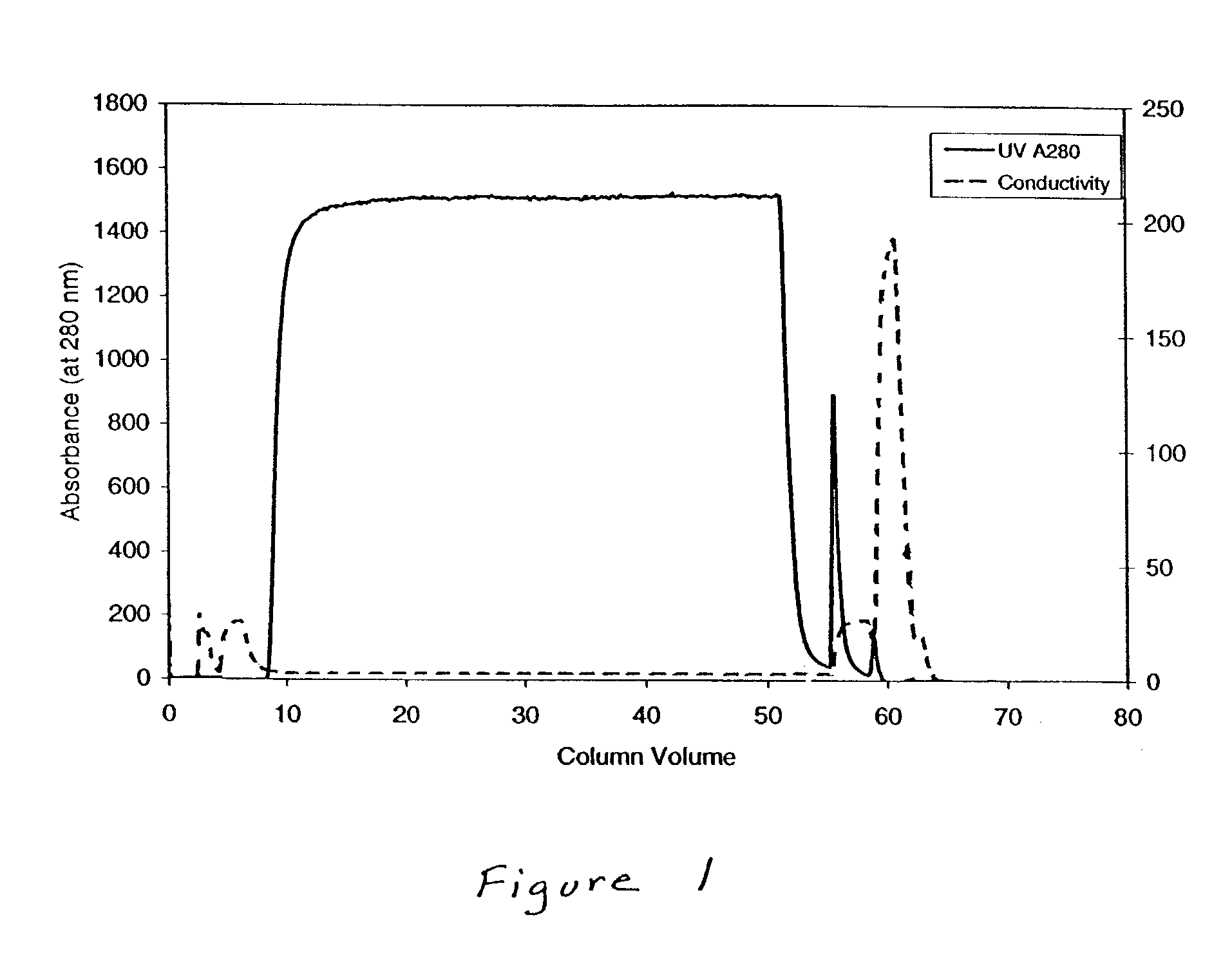Methods for purifying protein
a protein and purification technology, applied in the field of protein purification, can solve the problem that other protein contaminants may also be present in a sampl
- Summary
- Abstract
- Description
- Claims
- Application Information
AI Technical Summary
Benefits of technology
Problems solved by technology
Method used
Image
Examples
example 1
Reduction in Levels of Protein A in a Sample Comprising TNFR:FC Using Hydroxyapatite Chromatography
[0066]This experiment demonstrates that hydroxyapatite chromatography can reduce levels of residual protein A in a protein sample comprising TNFR:FC that contains a defined amount of protein A, which can form a complex with TNFR:FC.
[0067]A column of ceramic hydroxyapatite (Type II, Bio-Rad, 80μ) 18 cm in height and 1.6 cm in internal diameter was pre-equilibrated with two column volumes of 0.4 molar sodium phosphate, pH 6.8 and equilibrated with four column volumes of 25 millimolar sodium phosphate, pH 6.8, which has a conductivity of 2.8 milliSiemens (mS). A protein sample (5.11 milligrams / milliliter) in 668 milliliters of 25 mM sodium phosphate, pH 6.8 comprising TNFR:FC and protein A (209 ppm) was loaded onto the column. The amount of protein A in the sample was determined using an ELISA assay. The flow-through liquid, containing TNFR:FC, was collected. The column was washed with th...
example 2
Reduction in the Levels of Host Cell Proteins in a Sample Comprising TNFR:FC Using Hydroxyapatite Chromatography
[0068]The following experiment demonstrates that the levels of host cell proteins in a sample comprising TNFR:FC can be reduced by hydroxyapatite chromatography.
[0069]A column of ceramic hydroxyapatite (Type II, Bio-Rad, 80μ) 10 cm in height and 1.1 cm in internal diameter was pre-equilibrated with two column volumes of 0.3 molar sodium phosphate, pH 6.8 and equilibrated with three column volumes of 25 millimolar sodium phosphate, pH 6.8, which has a conductivity of 2.8 mS. About 1.9 grams of protein in a volume of 382 milliliters of 25 millimolar sodium phosphate, pH 6.8 was loaded onto the column. This sample included TNFR:FC, which comprised the vast majority of the sample, and host cell proteins (545 ppm). The amount of host cell proteins in the sample was determined using ELTSA assays. The flow-through liquid, comprising TNFR:FC, was collected. The column was washed w...
example 3
Reduction in Residual Protein A and Other Proteins in a Sample of TNFR:FC by Ceramic Hydroxyapatite Chromatography
[0071]The following experiment shows that levels of protein A and other protein contaminants can be simultaneously reduced using hydroxyapatite chromatography.
[0072]A column of ceramic hydroxyapatite (Type II, Bio-Rad, 80 μ) 18 cm in height and 1.6 cm in internal diameter was pre-equilibrated with two column volumes of 0.4 M sodium phosphate, pH 6.8 and equilibrated with three column volumes of 25 millimolar sodium phosphate, pH 6.8. About 3.2 grams of protein at about 5 mg / ml in 25 millimolar sodium phosphate comprising TNFR:FC, Protein A, which forms a complex with TNFR:FC under these conditions, (between about 97 ppm and about 106 ppm), and other process related impurities (PRI; between about 59 ppm and about 67 ppm) was loaded onto the column. The amounts of Protein A and PRI in the sample were determined using ELISA assays. The flow-through liquid, containing TNFR:F...
PUM
| Property | Measurement | Unit |
|---|---|---|
| pH | aaaaa | aaaaa |
| apparent molecular weight | aaaaa | aaaaa |
| height | aaaaa | aaaaa |
Abstract
Description
Claims
Application Information
 Login to View More
Login to View More - R&D
- Intellectual Property
- Life Sciences
- Materials
- Tech Scout
- Unparalleled Data Quality
- Higher Quality Content
- 60% Fewer Hallucinations
Browse by: Latest US Patents, China's latest patents, Technical Efficacy Thesaurus, Application Domain, Technology Topic, Popular Technical Reports.
© 2025 PatSnap. All rights reserved.Legal|Privacy policy|Modern Slavery Act Transparency Statement|Sitemap|About US| Contact US: help@patsnap.com

